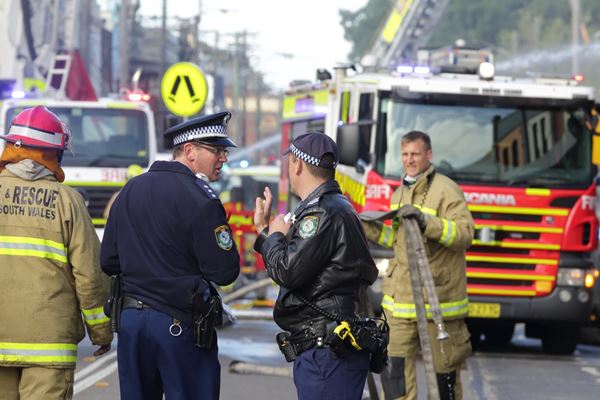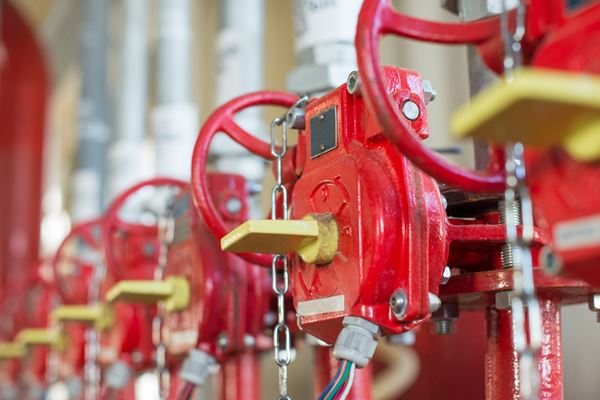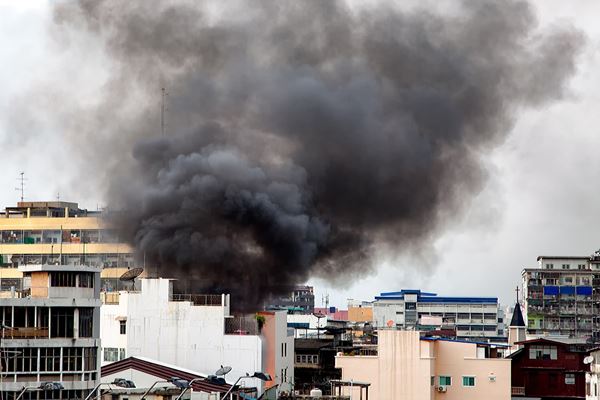Dryer Fires: Common Causes and Prevention Tips
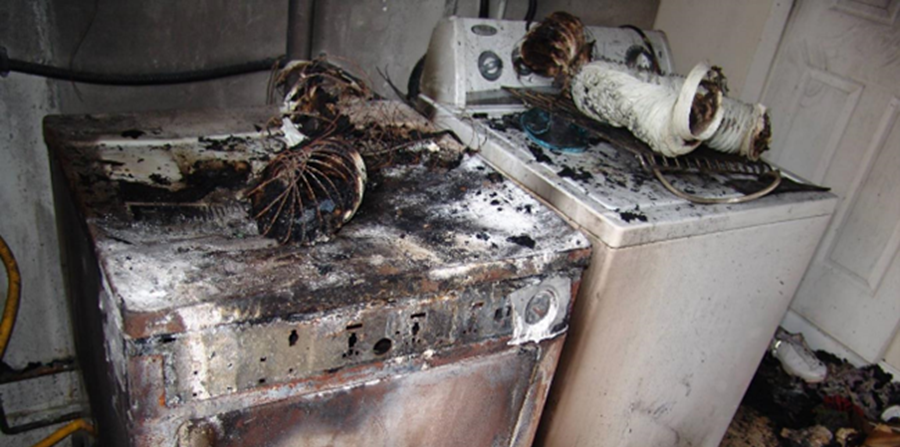
Clothes dryer fires are more common than you might think. The National Fire Protection Association (NFPA) reports that dryers and washing machines cause an average of 15,970 fires each year, with dryers causing 92% of them and an average of $200 million in property damage.1 More specifically, electric dryers are shown to be more than 2.5 times more likely than gas dryers to cause fires due to the higher heat discharge from electric dryers which increases the problem of lint buildup.2
Dryer fire hazards typically originate from two places, dryer venting and the lint trap. More than one-third of the fires are attributed to a failure to clean and perform routine maintenance. This means that many of these fires are preventable.
Common Causes of Dryer Fires
Lint Built-Up and Clogged Ducts
The most common cause of dryer fires is the result of lint build-up in the dryer and exhaust duct. When dryers are not cleaned on a regular basis the lint build-up restricts airflow, and when the airflow is restricted, clothes take longer to dry. This is the first indication that there is a problem.
Clothes dryers have at least one operational thermostat, a high-limit thermostat, and a thermal fuse. The purpose of the operational thermostat is to measure the temperature of the air flowing through the dryer. This is the temperature of the air that is drying the clothes. If the dryer vent has been pinched or has become clogged with lint, the air does not circulate through the dryer. The operational thermostat is not capable of measuring the temperature of the air flowing across the thermostat. With no airflow, the heat in the heater box will continue to rise until it activates the high-limit thermostat.
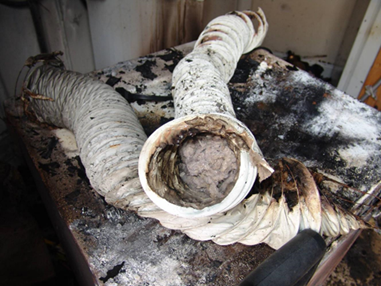
A family was talking about buying a new dryer because it was taking too long to dry their clothes. While investigating the laundry area in the garage, the dryer was pulled out to reach the vent. The vent was discovered to be completely blocked where it went into the wall and exited out the attic and a five-gallon bucket of lint was fished out from the vent. The exterior vent on the roof was also clogged, as the lint met exterior moisture and clogged the vent outlet.
Case Example 2: Blocking Dryer Duct
A brand-new dryer, less than a year old, started a residential house fire and the insured thought this would be an opportunity for subrogation. After examining and recreating the fire scene by bringing the dryer and other items back inside, it was found that the homeowner had rolled up an eight-foot by ten-foot floor rug and placed it behind the dryer for storage. In the process, the homeowner set the rolled rug on the plastic flexible exhaust duct and crushed the duct flat. The end of the duct had a lint ball that completely occluded the end and prevented the dryer airflow from moving through the vent as designed, therefore proving the dryer did not malfunction, but rather the homeowner’s mistake caused the fire.
Plastic and Flexible Dryer Ducts
According to the NFPA, all dryer manufacturers clearly state in their manuals to not use plastic or flexible dryer ducts between the vent and the clothes dryer, as they can be a fire hazard.3 Though, many homes continue to use plastic and flexible ducts.
Flexible vents can twist, allowing lint to build up and catch on fire if it meets a sufficient amount of heat. Only flexible transition ducts that are listed by UL or another approved product safety testing agency should be used.
Dryer Ventilation and Overloading
Serious hazards occur when dryer vents do not exhaust directly to the outside. Faulty installations can vent dryer exhaust into the attic, crawl space, chimney, or interior walls, which can cause indoor air deterioration and mold buildup. If heavy clothes, such as blue jeans or towels, are taking a long time to dry or clothes feel hotter than usual at the end of the cycle, a clogged dryer vent exhaust is likely the problem.
Use the dryer as it is meant to be used, not abused. Some materials are not to be dried in a clothes dryer. Look at the product labels and instructions for washing and drying. Certain plastics, rubbers, and synthetic foam materials should not be dried in the dryer.
There have also been various fires reported where the person had overloaded the dryer with too much clothing or bedding materials. The overloaded dryer could not move air through the drum causing it to overheat and begin to burn.
The last improper use is placing cotton towels contaminated with cooking oils in the dryer and leaving them. Tests have been run where the contaminated cotton towels have been dried and left in a pile where they spontaneously combusted. Spontaneous combustion occurs when a flammable or combustible substance is slowly heated to its ignition point through oxidation and many substances begin to release heat as they oxidize.
The process is sped up through heating in the dryer. Once the towels are removed and folded or placed in a pile, the heat has no way to escape, and the temperature will rise to a level high enough to ignite the oil and cause a fire in the towels or cloth.
Case Example 3: Dirty Towl Causes Fire
Firefighters responded to a dryer fire in the basement of a large two-story residence. The homeowner had been working on a motorcycle in the basement when the motorcycle fell over and spilt gasoline across the floor. He used multiple towels to clean the spilt gasoline, rinsed the towels, and put them outside to dry. When it started to rain, he brought them in and threw them into the electric clothes dryer. Needless to say, as they were drying, he started smelling smoke and found the towels on fire in the drum. He did not close the door to the dryer and the fire eventually burned throughout the house before being extinguished.
Subrogation Potential: Does Insurance Cover Dryer Fires?
Oftentimes, there is little subrogation potential due to the preventative nature of dryer fires. The few times there is a subrogation potential, power cords are usually involved, as faulty wiring and damaged machinery can cause dryer fires.
The most common problem is during the dryer installation process the installer fails to put the cord strain relief bracket in place. The strain relief, a plastic or metal clamp with smooth edges to protect the conductors where they enter the frame of the dryer, is installed to prevent chaffing of the conductors as they vibrate and move when the dryer is running. However, they are often not installed or installed improperly.
Dryer Fire Prevention Tips
Keep the following tips in mind when using dryer machines to help prevent fires.
- Clothes that no longer feel dry to the touch after a normal dry cycle are a telltale sign that something’s wrong. Before doing the next load, check for a plugged vent and clean out any lint.
- No matter where your laundry room is located, place a smoke detector on the ceiling above the dryer. I have a 10-year-rated smoke detector above my dryer, and if it sounds, all the smoke detectors in the house also sound.
- Never leave your dryer running when you leave the house. Many serious fires occur, and many pets die because of dryer fires.
- Never leave your dryer running when you go to bed. An average of over a dozen deaths and hundreds injured from dryer fires every year.
- Clean the entire duct system two or more times a year.
- Clean the lint filter after every load.
- Do not overload the dryer.
What to Do if Your Dryer Catches Fire?
If your dryer catches fire, it is crucial to act quickly and follow these steps to ensure your safety and minimize damage:
-
Stay calm and alert: Keep a clear mind to respond appropriately to the situation.
-
Safety first: If you notice smoke or flames coming from the dryer, your immediate priority is to protect yourself and others in the vicinity. Alert everyone in the house and ensure they evacuate to a safe location outside.
-
Cut off the power: Locate the dryer's power cord or unplug it from the electrical outlet, if it can be done safely. This step will prevent the fire from spreading further due to electrical power.
-
Call emergency services: Dial the emergency number (e.g., 911 in the United States) to inform the fire department about the situation. Provide them with your address and any relevant details about the fire.
-
Use a fire extinguisher (if available and safe): If you have a fire extinguisher and feel confident using it, attempt to put out the fire. However, do not jeopardize your safety or spend too much time fighting the fire if it continues to grow. Evacuate immediately if the fire becomes uncontrollable.
-
Close the door: If the fire is contained within the dryer, close the door to prevent the spread of flames or smoke to other parts of the house.
-
Do not use water: Avoid using water to extinguish an electrical fire, as it can conduct electricity and make the situation worse. Use a fire extinguisher specifically designed for electrical fires or a dry chemical extinguisher instead.
-
Wait for professional assistance: After evacuating and contacting emergency services, wait for the fire department to arrive. They are trained to handle fires and will have the necessary equipment to extinguish and ensure the fire is completely out.
-
Assess the damage: Once the fire is extinguished and the situation is under control, assess the damage caused by the fire. Contact your insurance company to report the incident and follow their instructions regarding the next steps.
Remember, the safety of yourself and others takes precedence over property. If you have any doubts about your ability to handle the situation safely, evacuate and wait for professional help.
Sources:
1 Report: NFPA's "Home Fires Involving Clothes Dryers and Washing Machines" Author: Richard Campbell Issued: March 2017
2 Report: NFPA's "Home Fires Involving Clothes Dryers and Washing Machines" Author: Richard Campbell Issued: March 2017
3 Report: NFPA's "Home Fires Involving Clothes Dryers and Washing Machines" Author: Richard Campbell Issued: March 2017
Our experts are ready to help.


